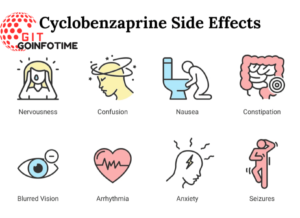Introduction
Doctors widely prescribe Cyclobenzaprine 10 mg as a muscle relaxant to relieve pain, stiffness, and discomfort caused by muscle injuries, strains, or spasms. As a common prescription, people typically take cyclobenzaprine 10 mg along with physical therapy, rest, and other treatments.This article provides a comprehensive overview of cyclobenzaprine 10 mg, including how it works, its uses, side effects, precautions, and answers to frequently asked questions.
What is Cyclobenzaprine 10 mg?
Cyclobenzaprine 10_mg is a muscle relaxant that acts on the central nervous system. The medication helps ease the symptoms of muscle strains, injuries, or spasms, allowing people to move more freely and comfortably. Cyclobenzaprine 10_mg is available in tablet form, and the dosage may vary depending on the severity of the muscle injury and individual response to the medication.
How Does Cyclobenzaprine 10 mg Work?
Cyclobenzaprine 10_mg works by blocking nerve impulses, or pain signals, sent to the brain. By interfering with these signals, cyclobenzaprine helps to reduce muscle stiffness and spasms, providing relief from discomfort. This effect allows the muscles to relax, promoting easier movement and aiding in recovery from muscle strains or injuries.
Uses of Cyclobenzaprine 10 mg
Cyclobenzaprine 10_mg is primarily prescribed to treat:
- Muscle spasms: Often caused by injury or overuse, muscle spasms are sudden, involuntary muscle contractions that can cause significant discomfort.
- Muscle strains and injuries: Cyclobenzaprine 10_mg helps to relieve pain and stiffness caused by muscle strains, sprains, or injuries.
- Acute musculoskeletal pain: This includes sudden or short-term muscle pain resulting from physical activities or accidents.
How to Take Cyclobenzaprine 10 mg
Taking cyclobenzaprine 10_mg correctly is essential to get the best results and avoid potential side effects. Here are the key instructions:
- Follow the doctor’s prescription: Always take cyclobenzaprine 10_mg as prescribed by your healthcare provider. Never increase or decrease the dose without consulting your doctor.
- Take with or without food: Cyclobenzaprine 10_mg can be taken with or without food. However, taking it with food may help to prevent stomach upset.
- Swallow the tablet whole: Do not crush, chew, or split the tablet, as this can affect how the medication is released and absorbed by the body.
Cyclobenzaprine 10_mg is typically taken once a day at bedtime, as it can cause drowsiness and should not be used when alertness is required, such as during work or driving.
Common Side Effects of Cyclobenzaprine 10 mg
Like any medication, cyclobenzaprine 10_mg can cause side effects. While not everyone experiences side effects, it’s essential to be aware of them:
- Drowsiness: Cyclobenzaprine 10_mg often causes drowsiness, so it’s recommended to avoid driving or operating heavy machinery while taking the medication.
- Dry mouth: One of the more common side effects, dry mouth, can be managed by sipping water throughout the day or chewing sugar-free gum.
- Dizziness: Some users report feeling dizzy, especially when standing up quickly. Moving slowly when getting up can help reduce this effect.
- Fatigue: Cyclobenzaprine 10_mg may make you feel tired, which is why it’s typically recommended to take it at night.
Most side effects are mild and go away on their own. However, if they persist or worsen, consult your healthcare provider.
Serious Side Effects of Cyclobenzaprine 10 mg
While rare, some people may experience more severe side effects. Seek medical attention if you experience any of the following:
- Irregular heartbeat: In some cases, cyclobenzaprine 10_mg can cause changes in heart rhythm, which may require medical intervention.
- Confusion or hallucinations: This is rare but should be reported to a doctor if it occurs.
- Allergic reactions: Symptoms such as rash, itching, swelling, or difficulty breathing require immediate medical help.
- Serotonin syndrome: When taken with other medications affecting serotonin, cyclobenzaprine 10_mg may increase the risk of serotonin syndrome, a serious condition. Symptoms include agitation, hallucinations, rapid heart rate, and muscle stiffness.
Precautions When Using Cyclobenzaprine 10 mg
Before taking cyclobenzaprine 10_mg, consider the following precautions:
- Medical history: Inform your doctor of any medical conditions, particularly liver disease, heart problems, or overactive thyroid, as these can affect how your body responds to cyclobenzaprine 10_mg.
- Interactions with other medications: Cyclobenzaprine 10_mg may interact with other drugs, including antidepressants, sedatives, and anti-anxiety medications. Ensure that your doctor is aware of all the medications and supplements you are taking.
- Alcohol: Avoid consuming alcohol while taking cyclobenzaprine 10_mg, as it can increase drowsiness and dizziness.
- Pregnancy and breastfeeding: Cyclobenzaprine 10_mg should only be used during pregnancy if absolutely necessary. Consult your healthcare provider if you are pregnant or planning to become pregnant.
How Long Does Cyclobenzaprine 10 mg Stay in Your System?
Cyclobenzaprine 10_mg typically stays in the body for about one to two days, though this may vary depending on factors such as age, metabolism, and liver function.”This medication may cause drowsiness and dizziness, so avoid operating heavy machinery or performing tasks that require full alertness until its effects have worn off.”
Can You Become Dependent on Cyclobenzaprine 10 mg?
However, if taken in higher doses or for extended periods, there is a risk of dependence. It is essential to follow the prescribed dosage and not to use it for longer than recommended.
Alternatives to Cyclobenzaprine 10 mg
In some cases, other muscle relaxants or pain relief methods may be more suitable. Alternatives to cyclobenzaprine 10_mg include:
Tizanidine:
Another muscle relaxant commonly prescribed for muscle spasms.
Methocarbamol:
Often used as an alternative to cyclobenzaprine, particularly in cases where sedation needs to be minimized.
Nonsteroidal anti-inflammatory drugs (NSAIDs):
such as ibuprofen, either in combination with or as an alternative to cyclobenzaprine 10_mg for pain relief.”

FAQs About Cyclobenzaprine 10 mg
1. Can I take cyclobenzaprine 10_mg every day?
- Doctors generally prescribe cyclobenzaprine 10_mg for daily use over a period of up to three weeks, but they do not recommend long-term use without medical supervision.
2. Does cyclobenzaprine 10_mg make you sleepy?
- Drowsiness is a common side effect of taking cyclobenzaprine 10_mg, so doctors usually recommend taking it at bedtime.
3. How long does it take for cyclobenzaprine 10_mg to work?
- Cyclobenzaprine 10_mg usually begins to work within 1 hour of taking it, with full effects seen within a few hours.
4. Can I drink alcohol while taking cyclobenzaprine 10_mg?
- No, alcohol can increase drowsiness and dizziness associated with cyclobenzaprine 10_mg and should be avoided.
5. Is cyclobenzaprine 10_mg safe during pregnancy?
- Only use Cyclobenzaprine 10+mg during pregnancy when absolutely necessary and under strict medical supervision. Consult with a healthcare provider for guidance.
6. How does cyclobenzaprine 10_mg compare to other muscle relaxants?
- Cyclobenzaprine 10_mg is one of several options for treating muscle spasms. Other options include tizanidine and methocarbamol, which may be prescribed based on individual needs and tolerability.
Conclusion
Cyclobenzaprine 10 mg acts as a popular muscle relaxant that relieves muscle spasms and discomfort associated with injuries. While it effectively provides short-term relief, patients should use this medication as prescribed, follow necessary precautions, and stay informed about potential side effects. Always consult with your healthcare provider regarding any concerns or questions about using cyclobenzaprine 10_mg.









